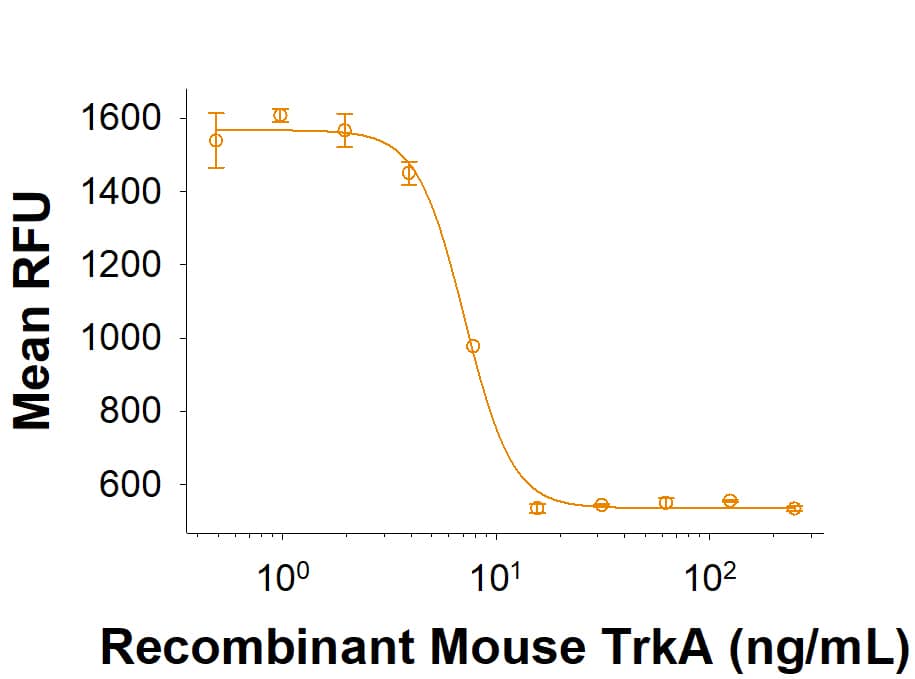Recombinant Mouse TrkA Fc Chimera Protein, CF
R&D Systems, part of Bio-Techne | Catalog # 10235-TK

Key Product Details
Source
NS0
Accession #
Structure / Form
Disulfide-linked homodimer
Conjugate
Unconjugated
Applications
Bioactivity
Product Specifications
Source
Mouse myeloma cell line, NS0-derived mouse TrkA protein
| Mouse TrkA (Ala34 - Pro418) Accession # Q3UFB7 |
IEGRMDP | Mouse IgG2a (Glu98 - Lys330) |
| N-terminus | C-terminus |
Purity
>95%, by SDS-PAGE visualized with Silver Staining and quantitative densitometry by Coomassie® Blue Staining.
Endotoxin Level
<0.10 EU per 1 μg of the protein by the LAL method.
N-terminal Sequence Analysis
Ala34
Predicted Molecular Mass
69 kDa
SDS-PAGE
100 - 125 kDa
Activity
Measured by its ability to inhibit NGF-induced proliferation of TF-1 human erythroleukemic cells.
The ED50 for this effect is 4-24 ng/mL in the presence of 2 ng/mL of Recombinant Mouse beta‑NGF (Catalog # 1156-NG).
The ED50 for this effect is 4-24 ng/mL in the presence of 2 ng/mL of Recombinant Mouse beta‑NGF (Catalog # 1156-NG).
Scientific Data Images for Recombinant Mouse TrkA Fc Chimera Protein, CF
Recombinant Mouse TrkA Fc Chimera Protein Bioactivity
Recombinant Mouse TrkA Fc Chimera (Catalog # 10235-TK) inhibits NGF-induced proliferation of TF-1 human erythroleukemic cells. The ED50 for this effect is 4-24 ng/mL in the presence of 2 ng/mL of Recombinant Mouse beta-NGF (Catalog # 1156-NG).Recombinant Mouse TrkA Fc Chimera Protein SDS-PAGE
2 μg/lane of Recombinant Mouse TrkA Fc Chimera (Catalog # 10235-TK) was resolved with SDS-PAGE under reducing (R) and non-reducing (NR) conditions and visualized by Coomassie® Blue staining, showing bands at 100-125 kDa and 200-250 kDa, respectively.Formulation, Preparation and Storage
10235-TK
| Formulation | Lyophilized from a 0.2 μm filtered solution in PBS. |
| Reconstitution | Reconstitute at 500 μg/mL in PBS. |
| Shipping | The product is shipped with polar packs. Upon receipt, store it immediately at the temperature recommended below. |
| Stability & Storage | Use a manual defrost freezer and avoid repeated freeze-thaw cycles.
|
Background: TrkA
References
- Harrington, A. et al. (2011) Cell. 146(3):421.
- Smeyne, R. et al. (1994) 368(6468):246.
- Barker, P. et al. (1992) 268(20):15150.
- Fagan, A. et al. (1996) J Neurosci. 16(19):6208.
- Yan, W. et al. (2019) J Med. Chem. 62(4):1731.
- Krupka, E. et al. (2019) Osteoarthr Cartil. DOI: 10:1016.
- Yosipovitch, R. et al. (2015) Acta Derm Venereol. 95.
Long Name
Neurotrophic Tyrosine Kinase Receptor A
Alternate Names
NTRK-1, NTRK1
Gene Symbol
NTRK1
UniProt
Additional TrkA Products
Product Documents for Recombinant Mouse TrkA Fc Chimera Protein, CF
Product Specific Notices for Recombinant Mouse TrkA Fc Chimera Protein, CF
For research use only
